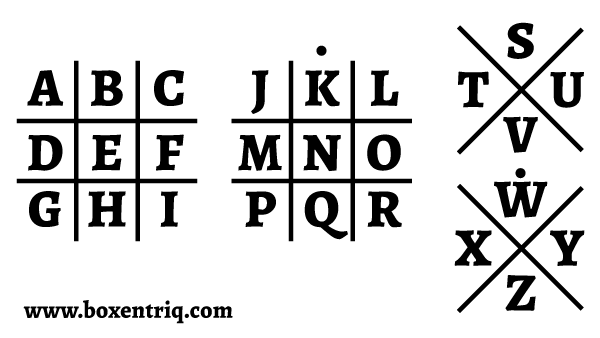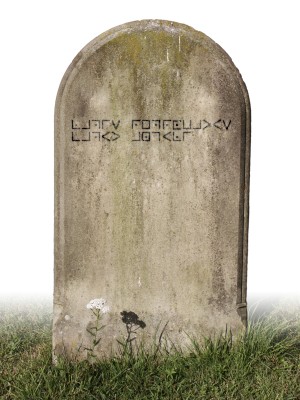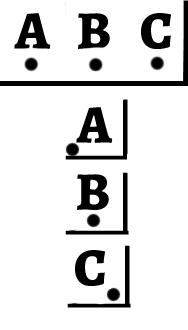If you come across an encrypted message that seems to consist of boxes, dots and the occasional triangle then you’ve probably found yourself an example of Pigpen cipher. The good news is that it’s simple to decode (and you can use our tool below if you really don’t want to try for yourself). The interesting part is that this cipher has a fascinating history include Kabbala, secret orders, freemasons, pirates and glamorous actresses!
Pigpen cipher tool
Alphabet
What is Pigpen Cipher?
Pigpen Cipher is a geometrical monoalphabetic substitution cipher. In other words, rather than using letters of the alphabet, you form words from geometric symbols. The cipher has been in use since the 1500s, and is also know by the names Masonic Cipher, Napoleonic Cipher, Tic-Tac-Toe Cipher, Pig Pen and Freemason’s Cipher.
The diagram below shows the key used for encrypting and decrypting something written in Pigpen Cipher.

To encode a message to Pigpen, find the letter you wish to encrypt and draw the lines that you see around it. For example:









To decode, you simply locate the shape you are looking at on the diagram to find the letter. Whether there is a dot in the shape will guide you to which grid you should be looking at.
History of Pigpen Cipher
Heinrich Cornelius Agrippa was a German with many talents, and one of those was writing about the occult. In 1531 he published, ‘Three Books of Occult Philosophy’, and in that he describes a version of what would eventually be called the Rosicrucian cipher. It is a similar cipher to Pigpen, but it uses only square grids to encode the letters.
The Rosicrucian Order was a group which emerged in the early 17th century when they published a series of papers. The order claimed to be, ‘Built on the esoteric truths of the ancient past’ however even at the time many viewed the papers as a hoax. Suspected members include infamous alchemist, John Dee.
The Freemasons began to use the Rosicrucian Cipher, and then Pigpen. They are perhaps the most famous and prolific users of this cipher, which is why it is often referred to as the Freemason’s Cipher.
Uses of Pigpen Cipher
Pigpen is a widely used cipher. Because it doesn’t need any specialist equipment to code or decode, it has been used by many people to hide the meaning of the notes they’ve left in their diaries or other documentation. Some of the more interesting uses of the cipher are:
Freemasons
Pigpen Cipher is used extensively in Freemason documentation. There are still surviving examples of letters written using the cipher from the 16th Century. It can also be found on Masonic medals, certificates, tokens and even gravestones.

Pirates!
In 1934, a well-respected historian by the name of Charles Bourrel de la Roncière published a book about a cryptogram he had deciphered. It was allegedly the work of the infamous pirate, Olivier Levassuer, also known as The Hawk (La Buse).
Bourrel had identified the cipher, which was a form of pigpen, and translated that into plaintext. However, that was where his problems began, as the message seemed to simply be a recipe for a folk remedy rather than the location of a hidden treasure.
The mystery here is why a reputable historian would publish a book about the cipher when he couldn’t solve it. There also doesn’t seem to be any evidence to link the cryptogram to Levassuer, so why would Bourrel put his reputation on the line?
The case was still fascinating people recently, when a new version of the cryptogram began circulating. It is a little more elaborate than Bourrel’s and includes several new lines of text which appear to give coordinates. Before you get too excited, they bear a strong resemblance to those encrypted in Edgar Allen Poe’s, ‘The Bug’ and so are probably a hoax.
Diana Dors
English actress and blonde bombshell, Diana Dors, was once considered a rival to Marilyn Monroe. When she passed away at the age of 52, she left behind an encoded message which only her husband had the key to. The message, it was said, led to millions of pounds which the actress had hidden.
Unfortunately, Dors’ husband died just a few months after her. Her son then faced the task of decrypting the message without the key. He noticed that the first part was in a version of Pigpen cipher and was able to decode that to read, ‘Locations and Names’.
Underneath that, was a message encoded using a different cipher. Eventually, Dors’ son got help from British Cryptoplogist, Andrew Clark who determined it was encoded with Vigenère Cipher. When decoded, it was a list of names and locations. However, what the list meant has never been determined and the money has not been recovered.
Font
If you like the idea of encrypting your information but you don’t want to write longhand then you’ll be delighted to know that you can download a pigpen font! Useful if you want to send an invitation to a puzzling party or create a treasure hunt with a difference.
Variations of the Pigpen Cipher
You might come across a piece of code that looks like pigpen but has some different symbols. If you find that, there’s a good chance that you are looking at one of the variants of Pigpen Cipher. The most commonly found versions of this are:
Rosicrucian Cipher
Take a 3x3 grid and write the alphabet in it, three letters to each square. Under each letter place a dot. Now, when you want to encode a message you draw the shape of the grid around the letter just like pigpen, but you place the dot in a different place for each letter. For example:

A variant of Rosicrucian is to use one to three dots, rather than different placement. A is 1 dot, B is two, and C is three, for example.
Switching Up the Grids
In standard pigpen, the letters are written over two grids and two crosses. By changing the order of grids, you can make a cipher that looks like simple pigpen but will take a little longer to decrypt. For example, rather than using the standard grid, grid, X, X, you could switch to grid, X, grid, X or X, grid, X grid. For example:

Switching up the Letters
Another way to ring the changes with Pigpen is to alter the order in which you write the letters in the grid. Forget going from A to Z or starting in one grid and filling it before moving to the next one. Perhaps reverse the letter order or put an alternate letter into each grid as they do in the Assassin’s Creed video game.
Including Numbers
There is also a variant of Pigpen which includes the numbers 0-9. This version expands the X grid to be 3 x 3. The letters take their usual places on the outside, while the digits are spread through the internal squares.
Can You Solve Your Way Out of a Pigpen?
Pigpen is often used as an introduction to cryptography because it is simple, visual, and effective. Of course, that also makes it one of the least secure ciphers. Even a person who had never heard of pigpen would stand a chance at cracking the code using frequency analysis.
While it might not be of much practical use in modern times, there is still a lot of fun to be had by using the pigpen cipher.
See also: Code-Breaking tools | Adfgvx cipher | Adfgx cipher | Affine cipher | Atbash cipher | Baconian cipher | Beaufort cipher | Bifid cipher | Caesar cipher | Columnar transposition | Cryptogram | Double transposition | Enigma machine | Four-square cipher | Gronsfeld cipher | Keyed caesar cipher | One-time pad | Playfair cipher | Rail fence cipher | Rot13 | Route transposition | Substitution cipher | Trifid cipher | Variant beaufort cipher | Vigenere cipher